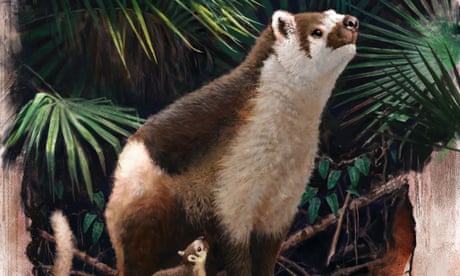Palaeontologists have identified the earliest example of a placental mammal in the fossil record to date, which could provide new insights into how our furry ancestors came to dominate Earth after the extinction of the dinosaurs. They made the breakthrough by studying the odontological (tooth) equivalent of tree rings – growth lines and elements preserved in fossil teeth – which they used to reconstruct the day-to-day life of one of our early cousins: Pantolambda bathmodon , a stocky dog-pig-like creature, which trotted around approximately 62m years ago – soon after the dinosaur extinction. Doing so revealed that Pantolambda mothers were pregnant for around seven months, before giving birth to a single, well-developed baby, sporting a mouthful of teeth, that suckled for only 1–2 months before becoming fully independent.
“Most of my career I’ve studied dinosaurs, but this project on mammal growth is the most exciting study I’ve ever been a part of, as I am astounded that we were able to identify chemical fingerprints of birth and weaning in teeth that are so old,” said Prof Stephen Brusatte at the University of Edinburgh, who was involved in the research. Placental mammals account for the majority of mammalian species alive today, from humans, to tiny shrews, to giant whales. They give birth to relatively mature young, that have done much of their growth inside their mother, nourished through a placenta.
Although mammals existed during the time of dinosaurs, it wasn’t until the latter went extinct that mammals really began to diversify and grow big. One idea is that their ability to birth large, well-developed babies that had previously been nourished by a placenta, was key to their success. This style of growth and reproduction is also what enables human babies to be born with such large brains.
Yet precisely when this lifestyle emerged has been a mystery. Because the bones of early mammals were small and fragile, fossilised remnants of, for instance, hip bones, that could be used to glean insights into species’ reproductive styles, are often lacking. Better preserved are teeth, the size and shape of which palaeontologists have long-studied to learn about the lifestyles of extinct mammals.
The new technique builds on this tradition. It involves slicing fossil teeth into extremely thin sections to examine growth lines, and vaporising them to understand their chemistry at different stages of development. “It allows us to look at virtually any fossil mammal and reconstruct things like its gestation period, how long it suckled for, when it reached maturity, and how long it lived for – things we really weren’t able to do in fossil mammals before now,” said Dr Gregory Funston at the University of Edinburgh, who led the research.
In the case of Pantolambda , Funston was surprised to discover quite how advanced this trait appeared to be at this point in mammalian evolution. “One of the closest analogues in terms of its development are things like giraffes, which are born right out on the plains, and they have to be moving within seconds or else they’re going to get hunted,” he said. “We would have expected these types of life histories to have arisen slowly, and then to have got more and more specialised over time, but what we’re seeing is that Pantolambda, only 4m years after the extinction, is already experimenting in this completely new way of life history.
” Funston hopes the study could open up a new frontier into research on fossil mammals, and how they evolved. “This method opens the most detailed window we could hope for into the daily lives of extinct mammals” he said. .
From: theguardian
URL: https://www.theguardian.com/science/2022/aug/31/earliest-example-of-placental-mammal-fossil-discovered



